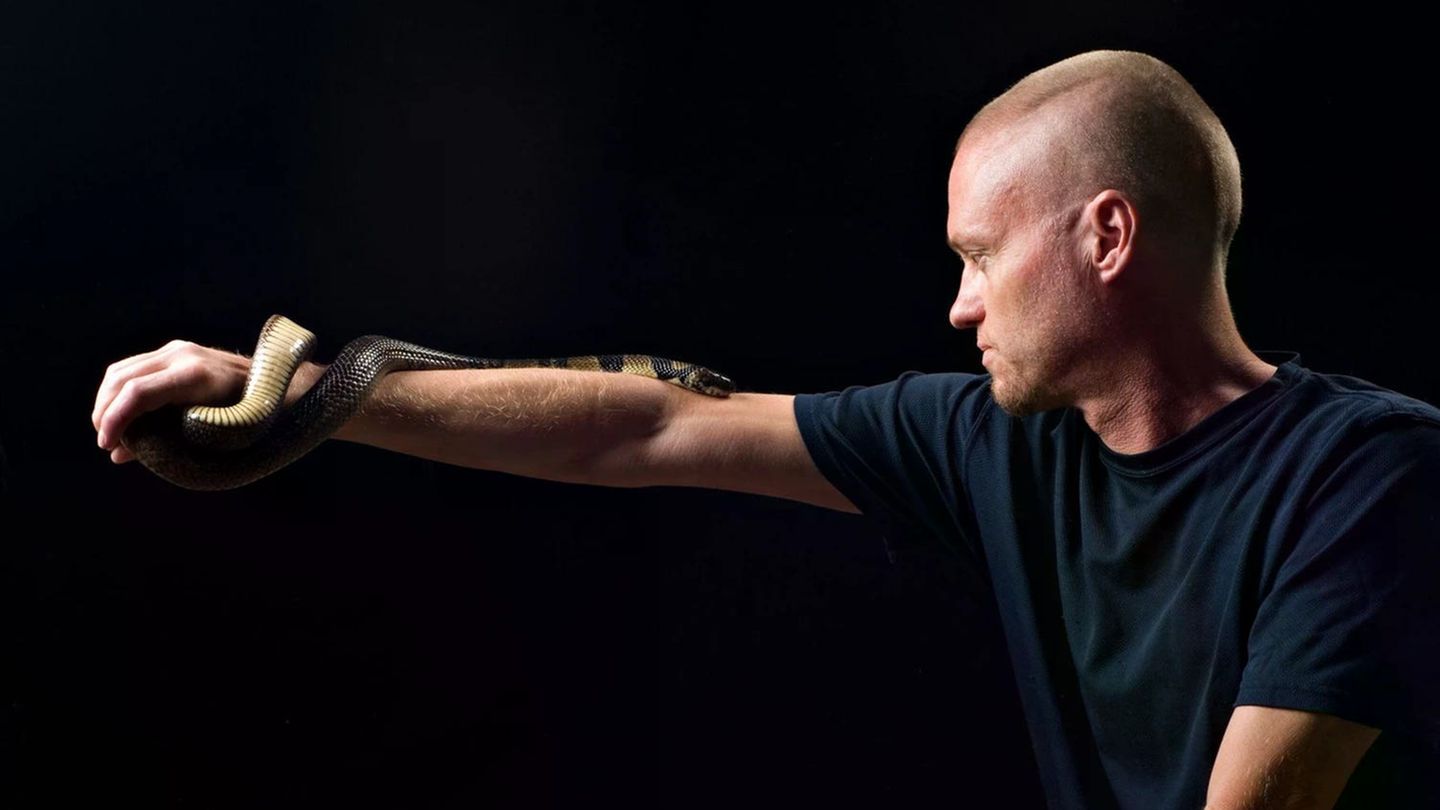Fatal snake bites
Man can bite toxic snakes to save thousands of life
Copy the current link
Add to the memorial list
Tim Friede was bitten by poisonous snakes hundreds of times. Now a universal antidote is to be developed from his blood. First tests on mice are promising
There is this saying by Nietzsche: “What does not kill you only make you stronger.” Psychologically more than controversial, the sentence is often brought into the field by people who unnecessarily put themselves in danger. The American Tim Friede is someone like that. The trained truck mechanic and snake lover from Wisconsin have voluntarily bitten by dangerous snakes such as cobras, mambas or rattling snakes in the past 18 years. And he gave himself the poison in rising doses.
Friedes had always liked to surround himself with dangerous snakes. His plan was initially only to become immune to those poisons that probably kill up to 138,000 people worldwide every year. Over time, however, he realized that the protective substances that his body forms with each of the dangerous self -experiments could also help other people. Since then, the hobby researcher has an idea: to develop an antiserum.
He almost died
In 2011, he would almost be the doom of the snake bites that were added, which you can also do: After he was bitten by Kobras twice in a row, he fell into a coma. He had already built some protection against the snakes. However, he almost died on the enormous amounts of poison that had spread after two bite in his body.
Researchers soon became aware of Tim Friede and his videos. In 2017, the immunologist Jacob Glanville contacted. The two men decided to work together.
“The exciting thing about the donor was his unique immunogy history,” says Glanville. “Over a period of almost 18 years, he had made hundreds of bites and self -vaccinations with escalating doses of 16 species of very fatal snakes that would normally kill a horse.”
A cocktail for 19 of the most poisonous snakes
In the meantime, Glenville has founded the start-up centivax, which is managed. The most important research object: Peace itself. In his hyperimmune blood, the researchers identified broadly neutralizing antibodies. In combination with a specific enzyme inhibitor, the cocktail acted in the first mouse experiments against the poison of 19 of the world’s most poisonous snakes.
The World Health Organization (WHO) is one of the most neglected diseases of the 21st century. Every year around five million people are bitten by snakes – many die, but even more loses limbs, are disfigured or then suffer from disabilities. Most victims live in Africa and Southeast Asia. The poorer a population is, the more likely the fatal encounter between humans and animals becomes. Around a quarter of the dead are children: the poison is particularly dangerous in the small bodies.
Now it is not the case that there have been no opposite tits, so -called antivenomas. They are obtained by animals such as horses or sheep that were immunized with the poison of a type of snake. However, there are around 600 types of poisonous snakes worldwide, and the antivenomas usually only work against a single type of snake or few related snakes. After a bite, it is therefore important to identify the right snake, which often does not succeed.
The antidote needs three components
Antiveenomas that work against several snake toxins could significantly simplify the treatment of snake victims. They would also be more interesting for manufacturers. Most pharmaceutical companies have withdrawn from the development of opposing poisons in recent years.
In order to develop a broad antivenome, the Centivax research team initially created a test plan with 19 of the fatalest snakes in category 1 and 2 of the World Health Organization. They all come from the Elapid family, the poison snakes. The group is said to include about half of all poisonous species, such as coral snakes, mambas, cobras, taipane and kit.
The researchers then wasolated antibodies from the donor’s blood and tested the protective substances on previously poisoned mice. In the end, the team worked with three main components: two antibodies areolated from Tim Friedes and a small molecule called Varespladib. As is known, this toxin inhibitor grants protection against other types of snakes.
Further tests should follow
“When we had reached the three components, we had an unprecedented range of complete protection for 13 of the 19 species – and partial protection for the other we examined,” says Glanville.
But not only the broad effect is a profit: “The antibodies obtained in the study are human antibodies. This is a clear advantage over the antibodies obtained from animals (Antibodies are proteins; editor’s note) Allergic reactions can quickly arise, “says Benno Kreuels, head of the working group neglected diseases and poisoning at the Bernhard Nocht Institute for Tropical Medicine (BNITM) in Hamburg.
After the antivenoma cocktail has proven to be effective in mouse models, the team wants to test its effectiveness in practice: by initially administering the antivenome dogs that are delivered to animal clinics in Australia because of snake bites. They also want to develop an antidote for the other large snake family, the vipers.
Years to use in humans
“We are now turning on the crank and making reagents to find out gradually which cocktail is at least sufficient to offer broad protection against vibilia,” says the main author Peter Kwong, professor at the Vagelos College of Physicians and Surgeons of the Columbia University and former employee of the National Institutes of Health. “The intended end product would be a single pan-antive cocktail.” Possibly, the researchers also make two. One for the elapids and one for the viperids, since in some areas of the world there is only one or the other kind.
However, it is still important to overcome some hurdles for Kreuels: “It is questionable how well the knowledge is transferable to humans because they have carried out their experiments with mice.” In addition, the mice would have received the antidote after just ten minutes. “It remains to be clarified how effective the antidote is when the affected mouse only gets it after hours,” said Kreuels. Because that is the time that would usually pass before those affected had found a medical facility. In addition, the right dose for use in humans still has to be determined.
Despite the convincing study results, people with such an antidote can be protected, so it should still take years.
Source: Stern
I’m Caroline, a journalist and author for 24 Hours Worlds. I specialize in health-related news and stories, bringing real-world impact to readers across the globe. With my experience in journalism and writing in both print and online formats, I strive to provide reliable information that resonates with audiences from all walks of life.




